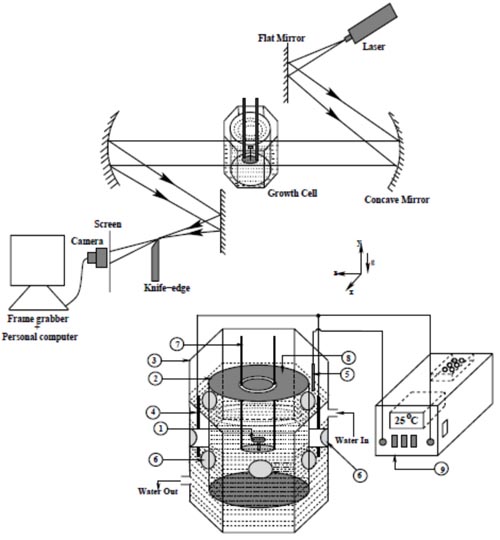| |
CRYSTAL GROWTH CHAMBER FOR TOMOGRAPHIC PROJECTIONS
Tomographic projection data are recorded by viewing the convection pattern at various angles over the range of  .If the pattern is strictly steady, projections can be recorded by turning the crystal through small incremental angles. This approach has the drawback of creating unsteadiness in the flow field. Results obtained by turning the crystal have been discussed in the context of validating the tomographic algorithm with measured data. An appropriate technique is to keep the growth chamber fixed and turn the axis of the source-detector system. This route could not be followed in the present study owing to the physical size of the laser, CCD camera and the accompanying optical components. Instead, the growth chamber along with the crystal was turned through definite angles to image the concentration field. The curvature of the beaker led to ray-bending problems and prevented scanning of its entire width. The portion of the solution visible through optical windows alone has been used for measurement. Unlike the top-hanging arrangement of previous sections (where the supporting rod disturbed the convective plumes), experiments have been conducted here using a crystal mounted above a platform. .If the pattern is strictly steady, projections can be recorded by turning the crystal through small incremental angles. This approach has the drawback of creating unsteadiness in the flow field. Results obtained by turning the crystal have been discussed in the context of validating the tomographic algorithm with measured data. An appropriate technique is to keep the growth chamber fixed and turn the axis of the source-detector system. This route could not be followed in the present study owing to the physical size of the laser, CCD camera and the accompanying optical components. Instead, the growth chamber along with the crystal was turned through definite angles to image the concentration field. The curvature of the beaker led to ray-bending problems and prevented scanning of its entire width. The portion of the solution visible through optical windows alone has been used for measurement. Unlike the top-hanging arrangement of previous sections (where the supporting rod disturbed the convective plumes), experiments have been conducted here using a crystal mounted above a platform.
The crystal growth chamber used in the present experiment is shown schematically in Figure 5.14.

Figure 5.14: Schematic diagram of the four-view crystal growth chamber placed in the path of the laser beam in a  schlieren set up. (1) Growing Crystal, (2) Growth Chamber, (3) Outer Chamber, (4) Heating element, (5) Thermocouple, (6) Optical window, (7) Seed holder (platform configration), (8) Covering Lid, (9) Temperature controller unit. schlieren set up. (1) Growing Crystal, (2) Growth Chamber, (3) Outer Chamber, (4) Heating element, (5) Thermocouple, (6) Optical window, (7) Seed holder (platform configration), (8) Covering Lid, (9) Temperature controller unit.
|